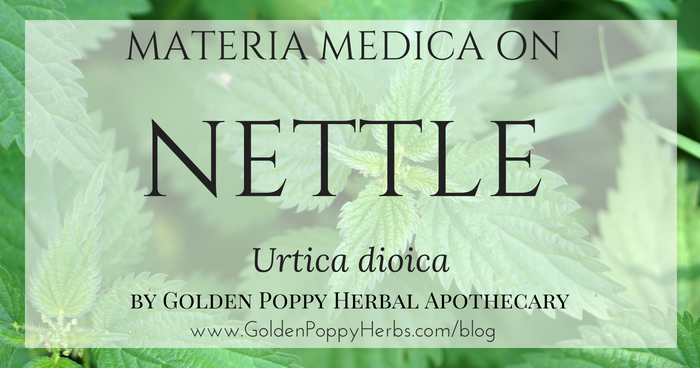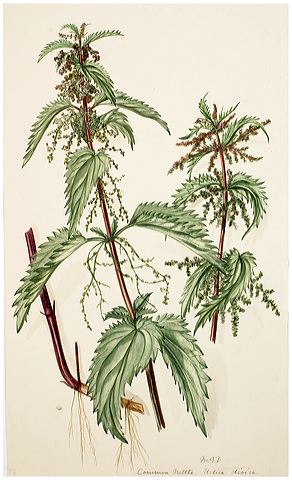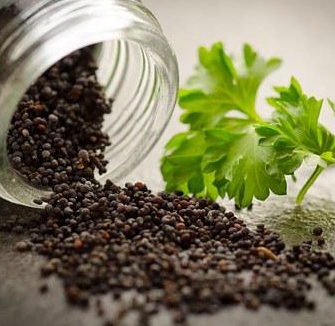
Named after the stinging hairs that cover the stem and underside of the leaves, this herb is known for having a myriad of uses.
Many health issues can often be traced back to nutrient deficiencies, even in our modern age, so including nettles in your daily tea is a good idea no matter what you are dealing with.

MATERIA MEDICA: STINGING NETTLE
Latin Name: Urtica dioica, U. urens
Family: Urticaceae (Nettle Family)
Energetics: salty, slightly bitter, cool, dry
Preparation:
Infusion – place 1/4 cup dried nettles into a quart sized Mason jar; cover with just boiled water; cover loosely and allow to steep overnight. In the morning strain and drink (you can re-heat the tea if you prefer).
Actions: Adrenal tonic, alterative, antiallergenic, anticatarrhal, antihistamine, anti-inflammatory, antioxidant, anthelmintic (seeds), antirheumatic, antiscorbutic, antiseptic (leaf and seed), astringent, blood tonic, carminative, cholagogue, circulatory stimulant, decongestant, depurative, diuretic, endocrine tonic (seeds), expectorant, febrifuge, galactagogue, hemostatic, hypoglycemic, kidney tonic, lithotriptic, mucolytic, nervine, nutritive, parturient, pectoral, rejuvenative (seeds), thyroid tonic (seeds), tonic (leaf, root, seed), styptic, uterine tonic, vermifuge (seeds)
Uses:
- Improves body’s resistance to pollens, molds, and environmental pollutants
- Nourishes and tones veins
- Prevents mucous membrane hyperactivity
- Improves veins’ elasticity
- Reduces inflammation
- Helps prevent blood clots, promotes healthy blood clotting
- Curbs appetite
- Cleanses toxins from body
- Acne
- Allergies
- Amenorrhea (due to blood or kidney deficiency)
- Anemia
- Arthritis
- Asthma
- Atherosclerosis
- Benign prostatic hyperplasia (BPH, enlarged prostate)
- Boils
- Bronchitis
- Candida
- Catarrh
- Cellulite
- Cough
- Cystitis
- Diabetes
- Diuretic
- Dysentery
- Eczema
- Edema
- Food Allergies
- Hair and scalp remedy for oily hair & dandruff
- Hay fever
- Headache
- Hemorrhage
- Hemorrhoids
- Hives
- Hypoglycemia
- Infertility (men and women)
- Jaundice
- Kidney Stones
- Leukemia
- Lumbago
- Menorrhagia
- Mononucleosis
- Nephritis
- Night sweats
- Obesity
- Pain
- Pleurisy
- Postpartum hemorrhage
- Premature gray hair
- Psoriasis
- Rheumatism
- Rickets
- Sciatica
- Sinusitis
- Tuberculosis
- Urinary Tract Disorders
- Varicose veins
- Vitiligo
Cautions:
- Nettles are generally considered safe, even over an extended period of time.
- The plant may even be used as a green, leafy vegetable.
- Stomach discomfort is the only reported adverse effect.
SOME OF THE PRODUCTS WE HAVE WITH NETTLES IN THEM:
- Daily Tea- a nourishing and mineral rich tea that is a great starter tea
- Pregnancy Tea & Nursing Tea – from the first 9-months, to the end of breast feeding, both you and your baby need extra nutrients, these teas are a great way to get more into your diet
SOME OTHER INTERESTING THINGS ON NETTLES:
- BBC article – http://news.bbc.co.uk/2/hi/uk_news/magazine/8692782.stm
- Book on nettles – http://www.amazon.com/Uses-Stinging-Nettles-Piers-Warren/dp/095418999X
- Wild-crafting nettles for food – http://www.wildmanstevebrill.com/Plants.Folder/Nettle.html
- A hospital’s monograph on nettle – http://umm.edu/health/medical/altmed/herb/stinging-nettle


